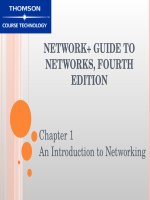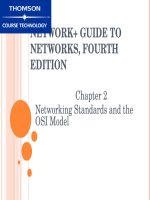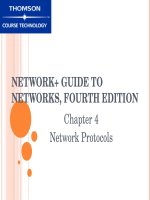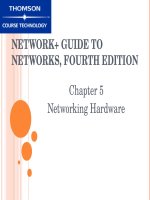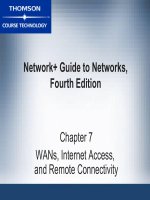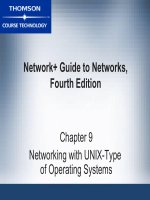Guide to network essentials 4th chapter 05
Bạn đang xem bản rút gọn của tài liệu. Xem và tải ngay bản đầy đủ của tài liệu tại đây (549.47 KB, 31 trang )
Chapter 5:
Making Networks Work
Learning Objectives
Understand and explain the OSI reference
model
Understand and explain the IEEE 802
networking model and related standards
Explain the OSI reference model’s layers and
their relationships to networking hardware and
software
Guide to Networking Essentials, F
2
OSI and 802 Networking Models
Models create intellectual framework to clarify
network concepts and activities
Open Systems Interconnection (OSI) reference
model is most successful model
Proposed
by International Organization for
Standardization (ISO)
IEEE 802 networking model is an influential set of
networking standards
Encompasses
most network types and is
open-ended, allowing additions for new types
Guide to Networking Essentials, F
3
Role of a Reference Model
Networking is built on common framework
Model clarifies process by breaking down
features and functionality into layers
Easier to comprehend
Helps with component compatibility
Guide to Networking Essentials, F
4
OSI Reference Model
Provides useful way to describe and think about
networking
Breaks networking down into series of
related tasks
Each aspect is conceptualized as a layer
Each task can be handled separately
Guide to Networking Essentials, F
5
Understanding Layers
Layering helps clarify process of networking
Groups related tasks and requirements
OSI model provides theoretical frame of
reference
Clarifies
what networks are
Explains how they work
Guide to Networking Essentials, F
6
OSI Reference Model Structure
Breaks networked communications into
seven layers, as seen in Figure 5-1:
Application
Presentation
Session
Transport
Network
Data
Link
Physical
Guide to Networking Essentials, F
7
Seven Layers of OSI Reference Model
Guide to Networking Essentials, F
8
OSI Reference Model Structure
A computer must have a protocol stack to access a
network
Most common network protocol stacks include:
Transmission
Control Protocol/Internet Protocol
(TCP/IP)
Internetwork Packet Exchange/Sequenced Packet
Exchange (IPX/SPX)
NetBIOS Enhanced User Interface (NetBEUI)
AppleTalk
Systems Network Architecture (SNA)
Guide to Networking Essentials, F
9
OSI Reference Model Structure (continued)
Protocols plus drivers equal network access
Each layer of OSI model communicates and
interacts with layers immediately above and
below it
Each layer responsible for different aspect of
data exchange
Each layer puts electronic envelope around data
as it sends it down layers or removes it as it
travels up layers for delivery
Guide to Networking Essentials, F
10
OSI Reference Model Structure (continued)
Interface boundaries separate layers
Individual layer communicates only adjacent
layers
“Peer layers” describes logical or virtual
communication between same layer on both
sending and receiving computers
See Figure 5-2
Guide to Networking Essentials, F
11
Relationships Among
OSI Layers
Guide to Networking Essentials, F
12
OSI Reference Model Structure (continued)
Date is broken into packets or payloads, called PDUs,
as it moves down stack
PDU stands for protocol data unit, packet data unit, or payload
data unit
PDU is self-contained data structure from one layer to
another
At sending end, each layer adds special formatting or addressing
to PDU, called a header
Adding information to the PDU is called encapsulation
At receiving end, each layer reads packet and strips off
information added (called de-encapsulation) by corresponding
layer at sending end
Guide to Networking Essentials, F
13
Application Layer
Layer 7 is top layer of OSI reference model
Provides general network access
Includes set of interfaces for applications to access variety of
networked services such as:
File transfer
E-mail message handling
Database query processing
May also include error recovery
PDU at this layer and the next two layers is referred to as data
Examples of software that resides at this layer include FTP, HTTP
(the protocol used to transfer Web pages), and components of client
software such as the Client for Microsoft Networks
Guide to Networking Essentials, F
14
Presentation Layer
Layer 6 handles data formatting and protocol conversion
Converts outgoing data to generic networked format
Performs data encryption and decryption
Handles character set issues and graphics commands
May include data compression
Includes redirector software that redirects service
requests across network
Software components that operate at this layer are
usually built into the Application layer
Guide to Networking Essentials, F
15
Session Layer
Layer 5 opens and closes sessions
Performs data and message exchanges
Monitors session identification and security
Performs name lookup and user login and logout
Provides synchronization services on both ends
Determines which side transmits data, when, and for how long
Transmits keep-alive messages to keep connection open
during periods of inactivity
Some of the common network functions handled by this layer
include name lookup and user login and logout
Guide to Networking Essentials, F
16
Transport Layer
Layer 4 conveys data from sender to receiver
Breaks long data payloads into chunks called segments
Includes error checks
Re-sequences chunks into original data on receipt
Handles flow control
PDU at this layer is called a segment
The components that work at this layer include the TCP
portion of the TCP/IP protocol suite and the SPX portion
of the IPX/SPX protocol suite
Guide to Networking Essentials, F
17
Network Layer
Layer 3 addresses messages for delivery
Translates logical network address into physical MAC
address
Decides how to route transmissions
Handles packet switching, data routing, and congestion
control
Through fragmentation or segmentation, breaks data
segments from Layer 4 into smaller PDUs called packets
Reassembles data packets on receiving end
The software components include the IP component of
TCP/IP and the IPX component of IPX/SPX
Routers operate at this layer
Guide to Networking Essentials, F
18
Data Link Layer
Layer 2 creates data frames to send to Layer 1
On receiving side, takes raw data from Layer 1 and
packages into data frames
Data frame is basic unit for network traffic on the wire
See Figure 5-3 for contents of typical data frame
Performs Cyclic Redundancy Check (CRC) to verify data
integrity
Detects errors and discards frames containing errors
PDU at Layer 2 is called a frame
The software component that operates at this layer is the
NIC driver; the hardware components that operate here
include the NIC and switches
Guide to Networking Essentials, F
19
Data Frame
Guide to Networking Essentials, F
20
Physical Layer
Layer 1 converts bits into signals for outgoing messages
and signals into bits for incoming messages
Manages computer’s interface to medium
Instructs driver software and network interface to send
data across medium
Sets timing and interpretation of signals across medium
Translates and screens incoming data for delivery to
receiving computer
The components include all of the cables and connectors
used on the medium plus repeaters and hubs
Guide to Networking Essentials, F
21
Actions of Each Layer of
OSI Reference Model
Guide to Networking Essentials, F
22
IEEE 802 Networking Specifications
Institute of Electrical and Electronic Engineers
(IEEE) started Project 802 to define LAN standards
Set standards to ensure compatibility among network
interfaces and cabling from different manufacturers
Concentrates on physical elements of network like
NICs, cables, connectors, and signaling technologies
Concentrates on lower two levels of OSI model:
Physical and Data Link layers
Guide to Networking Essentials, F
23
IEEE 802 Specifications
Project 802 includes many standards, numbered
802.1 through 802.20
For more information about 802 standards,
see />
Guide to Networking Essentials, F
24
IEEE 802 Extensions to the
OSI Reference Model
IEEE specification expanded OSI reference
model at Physical and Data Link layers
Breaks Data Link layer into two sublayers
Logical
Link Control (LLC) for error recovery
and flow control
Media Access Control (MAC) for access control
See Figure 5-4
Guide to Networking Essentials, F
25

